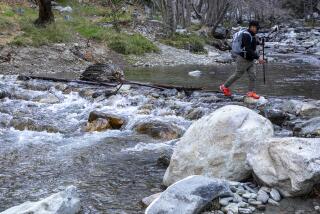Glendale reopens Deukmejian park, damaged in Station fire
For months, Glendale’s Deukmejian Wilderness Park has been closed to the public, first because its hillsides were scorched in last year’s Station fire and then because winter storms eroded portions of the park and filled it with mud and debris.
Just in time for the first day of summer, however, the “park closed” barrier was covered with a handwritten sign declaring it “open.”
Area residents have anxiously awaited the reopening of the park, which saw nearly all of its 709 acres blackened during the Station fire.
“We used to come here all the time to hike,” said Montrose resident Margaret Metz. “We are so excited it’s open again.”
“I don’t think any of us are ever going to forget the terror of the Station fire,” said Councilwoman Laura Friedman. But the park’s reopening will help to supplant “that horror” with new images, she said.
Only the lower portion of the park is open to the public, however. Much of its acreage and wilderness trails will remain closed as city officials and more than 300 volunteers continue recovery efforts, which have already taken thousands of hours.
“When people ask what makes the Crescenta Valley special, it’s how we respond when there are catastrophes,” said Councilman John Drayman, a Crescenta Valley native.
During the winter months, volunteers laid thousands of sandbags and city officials put up concrete barriers, called K-rails, to protect the park from mud and debris rushing down the barren hillsides.
In recent weeks, volunteers spread out across the hillsides to remove leafy castor bean and other nonnative plants that had taken root after the fire.
After the “grand reopening” ceremony, officials and residents took a short hike up one of the park’s lower trails to a historic oak tree that local firefighters saved. City officials dedicated the tree to retiring Assistant City Manager Bob McFall, a nature enthusiast who urged firefighters to protect the tree.
While the hillsides were still dotted with the blackened carcasses of burnt trees, those in attendance marveled at the wildlife that had returned.
Yellow mustard and other flowering plants filled the previously blackened hillsides with bright colors.
“You can already see this incredible regrowth,” Friedman said.
More to Read
Sign up for Essential California
The most important California stories and recommendations in your inbox every morning.
You may occasionally receive promotional content from the Los Angeles Times.










